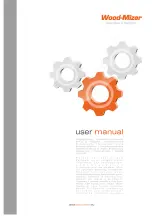
Page 17
WARNING!
Do not make any adjustments without first stopping the tractor engine, setting the brake,
removing the key, disconnecting the
hoses from the tractor hydraulic ports. Wait 10 minutes to allow all
parts to cool down. Always wear safety glasses during operation or while performing any adjustments or
repairs.
Beam and Splitting Wedge
Lubricate top, sides and bottom of the beam and where it comes into contact with the splitting wedge with engine oil
before each use.
If the wedge becomes dull or nicked, it can be sharpened.
Moving around
WARNING!
ALWAYS shut off your tractor hydraulic controls and your splitter controls to the “Neutral”
position before moving the log splitter on your tractor. Failure to do so may lead to improper performance
and compromise safety.
WARNING!
Never
attempt to move this machine on your tractor over hilly or uneven terrain without a tow
vehicle or adequate help.
1.
ALWAYS
check before moving to make sure that the log splitter is correctly and securely attached to the three point
hitches, and the hydraulic hoses to the pressure ports of tractor pump.
2. Lift the tractor 3-Point Hitch Arms to lift the log splitter the full height of the 3-Point Hitch range carefully for safely
transport.
3.
ALWAYS
be careful when backing up with your log splitter behind your tractor. It could jackknife.
Off-Season Storage
If the log splitter will not be used for more than 30 days, prepare it for storage as follows:
WARNING!
Never store the machine attached to the Tractor.
1. Clean the log splitter thoroughly.
NOTE:
The use of pressure washers or a garden hose to clean the splitter is not recommended. They may cause
damage to the bearings. The use of water will result in a shortened life and reduce serviceability.
2. Wipe the machine with an oiled rag to prevent rust, especially on the wedge and the beam.
3. Store the log splitter in a clean, dry area. Do not store it next to corrosive materials, such as fertilizer.
NOTE:
If storing in an unventilated or metal storage shed, be certain to rustproof the equipment by coating it with a light
oil or silicone.
MAINTENANCE & ADJUSTMENTS
Page 20





























